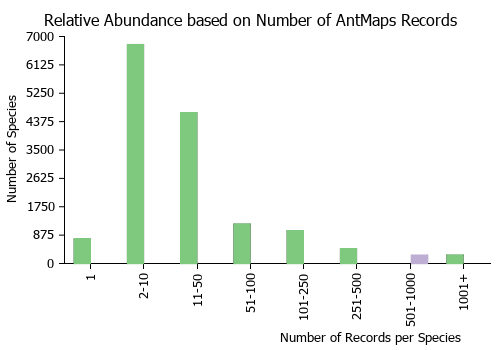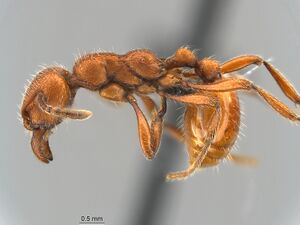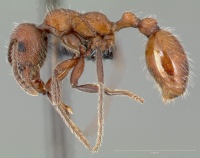Manica invidia
| Manica invidia | |
|---|---|

| |
| Scientific classification | |
| Kingdom: | Animalia |
| Phylum: | Arthropoda |
| Class: | Insecta |
| Order: | Hymenoptera |
| Family: | Formicidae |
| Subfamily: | Myrmicinae |
| Tribe: | Myrmicini |
| Genus: | Manica |
| Species: | M. invidia |
| Binomial name | |
| Manica invidia Bolton, 1995 | |
| Synonyms | |
| |
This is the most widespread North American species of the genus. Found in a large number of habitats and elevations in the West, it often has dense concentrations of nests. It is host for the xenobiotic ant Formicoxenus chamberlini.
Identification
Slightly larger and similar to Myrmica but red or golden yellow in color.
Identification Keys including this Taxon
Key to Manica of North America
Distribution
From the eastern slopes of the Sierra Nevada and the Cascade Range in California, eastward to northeastern New Mexico, Colorado, Wyoming, the Black Hills of South Dakota and southwestern North Dakota, northwestward into British Columbia and Alberta, with 1 record from Alaska. (Wheeler and Wheeler 1986)
There is a single record of this species in Arizona collected from Jacob Lake at 7,900 feet (north rim of Grand Canyon) and published by Cole in 1937 in his list of ants of Arizona. This locality needs to be confirmed.
Latitudinal Distribution Pattern
Latitudinal Range: 53.917° to 34.156971°.
| North Temperate |
North Subtropical |
Tropical | South Subtropical |
South Temperate |
- Source: AntMaps
Distribution based on Regional Taxon Lists
Nearctic Region: Canada, United States (type locality).
Distribution based on AntMaps
Distribution based on AntWeb specimens
Check data from AntWeb
Countries Occupied
| Number of countries occupied by this species based on AntWiki Regional Taxon Lists. In general, fewer countries occupied indicates a narrower range, while more countries indicates a more widespread species. |

|
Estimated Abundance
| Relative abundance based on number of AntMaps records per species (this species within the purple bar). Fewer records (to the left) indicates a less abundant/encountered species while more records (to the right) indicates more abundant/encountered species. |

|
Habitat
Occurs in a number of habitats, usually forests (aspen, pine, spruce), but may occur in areas with sagebrush or in arid grasslands (Mackay and Mackay 2002).
Biology
This wide ranging species is known from a variety of habitats including openings in coniferous forests, deciduous forests (river fringes), pinyon-juniper woodlands, grasslands, sagebrush, and cold deserts. It can be found in disturbed areas including parks, lawns, along highways and in areas with low vegetation and bare areas. It is not found in densely wooded areas.
Nuptial flights have been observed in late September. Colonies are started by multiple queens. Colony size can be as large as 400 workers for older nests. This species is the host for Formicoxenus chamberlini in Utah near Salt Lake City.
This species nests under stones and logs or simply in the soil with sand craters. Where this ant is found there is often a dense number of nest entrances. Workers feed on living insects and seeds. Reproductives are found in the nest from August to October. Although possessing a painful sting they are not aggressive. It is found between 4,000 and 9,000 feet in elevation.
Wheeler (1903) - About Colorado Springs, Colo., the nests of Manica invidia are of common, though sporadic occurrence. I have found them only in the loose silt and fine gravel of creek bottoms, especially along Monument Creek, Cheyenne Creek, and the tributaries of the Fontaine qui Bouille. Though I dug up many of the nests I was not fortunate enough to find Formicoxenus chamberlini in any of these localities.
Castes
Worker
   
| |
| . | Owned by Museum of Comparative Zoology. |
Nomenclature
The following information is derived from Barry Bolton's Online Catalogue of the Ants of the World.
- mutica. Myrmica mutica Emery, 1895c: 311 (w.) U.S.A. (Colorado).
- Type-material: syntype workers (number not stated).
- Type-locality: U.S.A.: Colorado, Denver (Pergande).
- Type-depository: MSNG.
- [Junior primary homonym of Myrmica mutica Nylander, 1849: 39.]
- Wheeler, W.M. 1914d: 120 (q.m.); Wheeler, G.C. & Wheeler, J. 1960b: 5 (l.).
- Combination in Myrmica (Oreomyrma): Wheeler, W.M. 1914d: 119;
- combination in M. (Neomyrma): Emery, 1915d: 69 (footnote); Forel, 1915c: 364;
- combination in M. (Manica): Emery, 1921f: 43;
- combination in Manica: Wheeler, G.C. & Wheeler, E.W. 1944: 244.
- Status as species: Wheeler, W.M. 1910g: 566; Wheeler, W.M. 1914d: 119 (redescription); Forel, 1915c: 364; Wheeler, W.M. 1917a: 507; Emery, 1921f: 43; Essig, 1926: 862; Cole, 1936a: 36; Cole, 1937b: 135; Wheeler, G.C. & Wheeler, E.W. 1944: 244; Creighton, 1950a: 109; Smith, M.R. 1951a: 791; Cole, 1953e: 243; Cole, 1957c: 213 (in key); Smith, M.R. 1958c: 113; Smith, M.R. 1967: 351; Wheeler, G.C. & Wheeler, J. 1970a: 154 (redescription); Wheeler, G.C. & Wheeler, J. 1972b: 235; Yensen, et al. 1977: 182; Smith, D.R. 1979: 1352; Snelling, R.R. & George, 1979: 46; Allred, 1982: 486; Wheeler, G.C. & Wheeler, J. 1986g: 25.
- Replacement name: Manica invidia Bolton, 1995b: 249.
- invidia. Manica invidia Bolton, 1995b: 249.
- Replacement name for Myrmica mutica Emery, 1895c: 311. [Junior primary homonym of Myrmica mutica Nylander, 1849: 39.]
- Status as species: Mackay & Mackay, 2002: 143; Ward, 2005: 66.
- Distribution: Canada, U.S.A.
Description
Worker
Head subrectangular, as broad as long, with straight lateral borders and rounded posterior corners. Eyes at the middle of the sides. Clypeus convex, its anterior border very feebly sinuate in the middle. Mandibles with two large apical and about a dozen minute basal teeth. Antennal scapes, rather strongly curved and slightly flattened at the base, scarcely reaching beyond the posterior corners of the head. Funicular club 5-jointed. Thorax in profile with rounded pronotum and the mesonotum gently sloping to a rather deep constriction in front of the epinotum, which has a subequal base and declivity, the former feebly convex, the latter sloping and nearly straight. Petiole in profile longer than high, its node bluntly rounded, with concave anterior and convex posterior slopes; ventral surface of peduncle in front with a small, acute tooth. Postpetiole scarcely longer than broad, a little broader behind than in front, somewhat broader than the petiole; its ventral surface in profile straight. Gaster a little larger than the head. Legs long, tibiae and femora feebly clavate.
Subopaque; dental border of mandibles, postpetiole, gaster and legs shining. Mandibles, frontal area and front longitudinally rugose; remainder of the head longitudinally and rather indistinctly punctate-rugulose. Thorax finely rugose, longitudinally on the pleurae, pro- and mesonotum, transversely and more coarsely on the epinotum, Petiole and ventral portion of postpetiole finely and densely punctate. Gaster and legs with small, scattered, piligerous punctures. Hairs white, erect or suberect, coarse, rather short, abundant on all parts of the body, legs and scapes. Ferruginous red; gaster slightly paler; frontal area, and in some specimens also the antennal clubs, infuscated; mandibular teeth black.
Queen
Length, 6.5-7.5 ram. Closely resembling the worker, Postpetiole in some specimens opaque rugulose, or with only the node smooth and shining. Mesonotum and scutellum sharply and regularly longitudinally rugose, the former with an anteromedian and a pair of parapsidal blackish streaks. Wings grayish hyaline; veins pale brown, stigma dark brown.
Male
Length, 6-7 ram. Head, including the eyes and excluding the mandibles, distinctly broader than long, rounded behind. Mandibles similar to those of the worker, with two large apical and numerous minute basal teeth. Clypeus very convex, with entire anterior border. Antennm slender; scapes very short, not longer than the second funicular joint; which is three times as long as the first and of the same length as the succeeding joints. There is no differentiated club. Thorax rather small, narrower than the head through the eyes, with very distinct Mayrian furrows. Scutellum convex, epinotum, petiole and postpetiole much as in the worker. Gaster more slender, with the genital appendages proportionally larger and more exserted than in M. rubida. Shining; head opaque, indistinctly punctate and longitudinally rugulose; thorax subopaque, more shining above, longitudinally rugose-punctate even on the epinorum. Sides and ventral portions of petiole finely and densely punctate. Hairs much as in the worker but more delicate and flexuous. Black; dental borders of mandibles, tibia and tarsi brown or sordid yellowish; gaster red, often brownish in the middle above; base of first segment sometimes black or all of the gaster, except the base of the first segment, black. In other specimens the postpetiole is red. Wings colored as in the female.
- Type Locality
Denver, Colorado
E. Bethel (Theo Pergande?)
References
- Allred, D. M.; Cole, A. C., Jr. 1971. Ants of the National Reactor Testing Station. Great Basin Naturalist 31:237-242.
- Snelling, R. R. 1969c. Notes on the systematics and dulosis of some western species of Formica, subgenus Raptiformica (Hymenoptera: Formicidae). Proc. Entomol. Soc. Wash. 71: 194-197.
- Wheeler, W. M. 1910b. Ants: their structure, development and behavior. New York: Columbia University Press, xxv + 663 pp.
- Yensen, N. P.; Clark, W. H.; Francoeur, A. 1977. A checklist of Idaho ants (Hymenoptera: Formicidae). Pan-Pac. Entomol. 53: 181-187.
- Bolton, B. 1995b. A new general catalogue of the ants of the world. Cambridge, Mass.: Harvard University Press, 504 pp. (page 249, new name)
- Buschinger, A. & Francoeur, A. 1983. The guest ant Symmyrmica chamberlini, rediscovered near Salt Lake City, Utah. Psyche 90: 297-306. [9.xii.1983.]
- Clark, W. H.; Blom, P. E. 2007. Annotated checklist of the ants on the Idaho National Laboratory (Hymenoptera: Formicidae). Sociobiology 49(2):1-117.
- Cole, A. C., Jr. 1934c. An annotated list of the ants of the Snake River Plains, Idaho (Hymenoptera: Formicidae). Psyche (Cambridge) 41:221-227. [1934-12]
- Cole, A. C., Jr. 1937a. An annotated list of the ants of Arizona (Hymen.: Formicidae). [part]. Entomological News 48:97-101. [1937-04-13.
- Cole, A. C., Jr. 1942. The ants of Utah. Am. Midl. Nat. 28: 358-388.
- Cole, A. C., Jr. 1953f. Studies of New Mexico ants. IV. The genera Myrmica, Manica, Aphaenogaster, and Novomessor (Hymenoptera: Formicidae). J. Tenn. Acad. Sci. 28: 242-244.
- Cole, A. C., Jr. 1957c. Descriptions of sexual castes of some ants in the genera Myrmica, Manica and Xiphomyrmex from the western United States (Hymenoptera: Formicidae). J. Tenn. Acad. Sci. 32: 208-213.
- Emery, C. 1895d. Beiträge zur Kenntniss der nordamerikanischen Ameisenfauna. (Schluss). Zool. Jahrb. Abt. Syst. Geogr. Biol. Tiere 8: 257-360. (page 311, replacement name for Myrmica mutica)
- Fales, H.M., Blum, M.S., Crewe, R.M. and J.M. Brand. 1972. Alarm pheromones in the genus Manica derived from the mandibular gland. Journal of Insect Physiology 18:1077-1088.
- Francoeur, A.; Loiselle, R.; Buschinger, A. 1984. Taxonomic revision of the ant genus Formicoxenus (Formicidae, Hymenoptera). [Abstract.] P. 528 in: XVII International Congress of Entomology. Hamburg, Federal Republic of Germany, August 20-26, 1984. Abstract Volume. Hamburg: XVII International Congress of Entomology, 960 pp. [1984-VIII-10] in Zool. Record (1984). New combinations and new species (nomen nudum?) here that predate Francoeur, Loiselle & Buschinger (1985).
- Gregg, R. E. 1963. The ants of Colorado, with reference to their ecology, taxonomy, and geographic distribution. Boulder: University of Colorado Press, xvi + 792 pp.
- Herbers, J. M. 1988. Manica mutica in Gunnison County, Colorado. Pp. 157-159 in: Trager, J. C. (ed.) 1988. Advances in myrmecology. Leiden: E. J. Brill, xxvii + 551 pp.
- Jansen, G., Savolainen, R. 2010. Molecular phylogeny of the ant tribe Myrmicini (Hymenoptera: Formicidae). Zoological Journal of the Linnean Society 160(3), 482–495 (doi:10.1111/j.1096-3642.2009.00604.x).
- Jansen, G., Savolainen, R., Vepsäläinen, K. 2010. Phylogeny, divergence-time estimation, biogeography and social parasite–host relationships of the Holarctic ant genus Myrmica (Hymenoptera: Formicidae). Molecular Phylogenetics and Evolution 561, 294–304 (doi:10.1016/j.ympev.2010.01.029).
- Mackay, W.P. & Mackay, E.E. 2002. The Ants of New Mexico: 400 pp. Edwin Mellen Press, Lewiston, N.Y.
- Nylander, W. 1849 [1848]. Additamentum alterum adnotationum in monographiam formicarum borealium. Acta Soc. Sci. Fenn. 3: 25-48 (page 39, junior primary homonym of Myrmica mutica)
- Wheeler, G. C. and J. Wheeler. 1986. The ants of Nevada. Natural History Museum of Los Angeles County, Los Angeles.
- Wheeler, G. C.; Wheeler, E. W. 1944. The ants of North Dakota. N. D. Hist. Q. 11: 231-271.
- Wheeler, G. C.; Wheeler, J. 1960b. Supplementary studies on the larvae of the Myrmicinae (Hymenoptera: Formicidae). Proc. Entomol. Soc. Wash. 62: 1-32.
- Wheeler, G. C.; Wheeler, J. 1963. The ants of North Dakota. Grand Forks, North Dakota: University of North Dakota Press, viii + 326 pp.
- Wheeler, G. C.; Wheeler, J. 1970a. The natural history of Manica (Hymenoptera: Formicidae). Journal of the Kansas Entomological Society 43:129-162.
- Wheeler, G. C.; Wheeler, J. 1972b. Ant larvae of the subfamily Myrmicinae: second supplement on the tribes Myrmicini and Pheidolini. J. Ga. Entomol. Soc. 7: 233-246.
- Wheeler, G. C.; Wheeler, J. 1988e. A checklist of the ants of Wyoming (Hymenoptera: Formicidae). Insecta Mundi 2:231-239.
- Wheeler, W. M. 1904a. Three new genera of inquiline ants from Utah and Colorado. Bull. Am. Mus. Nat. Hist. 20: 1-17.
- Wheeler, W. M. 1914e. The American species of Myrmica allied to M. rubida Latreille. Psyche (Camb.) 21: 118-122.
- Wheeler, W. M. 1917a. The mountain ants of western North America. Proc. Am. Acad. Arts Sci. 52: 457-569.
- Zharkov, D., Dubovikoff, D., Abakumov, E. 2022. The first fossil record of the genus Manica Jurine, 1807 from Late Eocene Baltic amber and discussion of the early evolution of Myrmicini (Hymenoptera: Formicidae: Myrmicinae). Insects, 14, 21 (doi:10.3390/insects14010021).
References based on Global Ant Biodiversity Informatics
- Allred D. M. 1982. Ants of Utah. The Great Basin Naturalist 42: 415-511.
- Allred, D.M. 1982. The ants of Utah. Great Basin Naturalist 42:415-511.
- Cole A. C., Jr. 1942. The ants of Utah. American Midland Naturalist 28: 358-388.
- Cole, A.C. 1936. An annotated list of the ants of Idaho (Hymenoptera; Formicidae). Canadian Entomologist 68(2):34-39
- Gregg, R.T. 1963. The Ants of Colorado.
- Johnson R. Personnal Database. Accessed on February 5th 2014 at http://www.asu.edu/clas/sirgtools/resources.htm
- Knowlton G. F. 1970. Ants of Curlew Valley. Proceedings of the Utah Academy of Sciences, Arts and Letters 47(1): 208-212.
- La Rivers I. 1968. A first listing of the ants of Nevada. Biological Society of Nevada, Occasional Papers 17: 1-12.
- Lidgren, B.S. and A.M. MacIsaac. 2002. A Preliminary Study of Ant Diversity and of Ant Dependence on Dead Wood in Central Interior British Columbia. USDA Forest Service Gen. Tech. Rep. PSW-GTR-181.
- Lindgren, B.S. and A.M. MacIsaac. 2002. Ant dependence on dead wood in Central Interior British Columbia. USDA Forest Service Gen. Tech. Rep.PSW-GTR-181
- Longino, J.T. 2010. Personal Communication. Longino Collection Database
- Mackay W. P., and E. E. Mackay. 2002. The ants of New Mexico (Hymenoptera: Formicidae). Lewiston, New York: Edwin Mellen Press, 400 pp.
- Michigan State University, The Albert J. Cook Arthropod Research Collection. Accessed on January 7th 2014 at http://www.arc.ent.msu.edu:8080/collection/index.jsp
- Smith F. 1941. A list of the ants of Washington State. The Pan-Pacific Entomologist 17(1): 23-28.
- Wheeler G. C., and E. W. Wheeler. 1944. Ants of North Dakota. North Dakota Historical Quarterly 11:231-271.
- Wheeler G. C., and J. Wheeler. 1986. The ants of Nevada. Los Angeles: Natural History Museum of Los Angeles County, vii + 138 pp.
- Wheeler W. M. 1914. The American species of Myrmica allied to M. rubida Latreille. Psyche (Cambridge) 21: 118-122.
- Wheeler W. M. 1917. The mountain ants of western North America. Proceedings of the American Academy of Arts and Sciences 52: 457-569.
- Wheeler, G.C. and J. Wheeler. 1970. The natural history of Manica (Hymenoptera: Formicidae). Journal of Kansas Entomological Society 43(2):129-162
- Wheeler, G.C. and J. Wheeler. 1988. A checklist of the ants of Wyoming. Insecta Mundi 2(3&4):230-239

